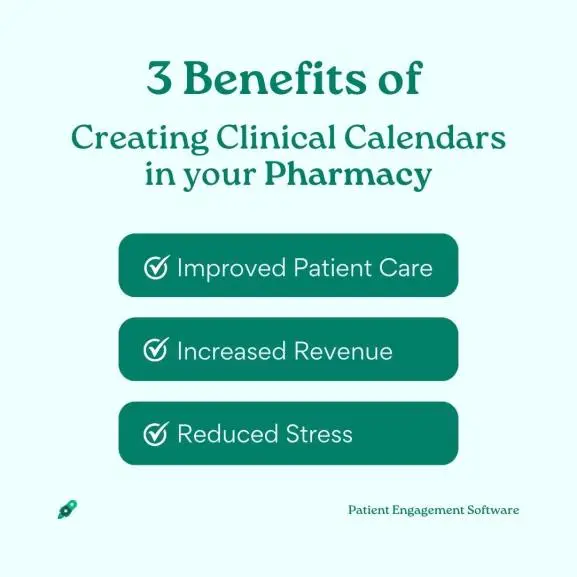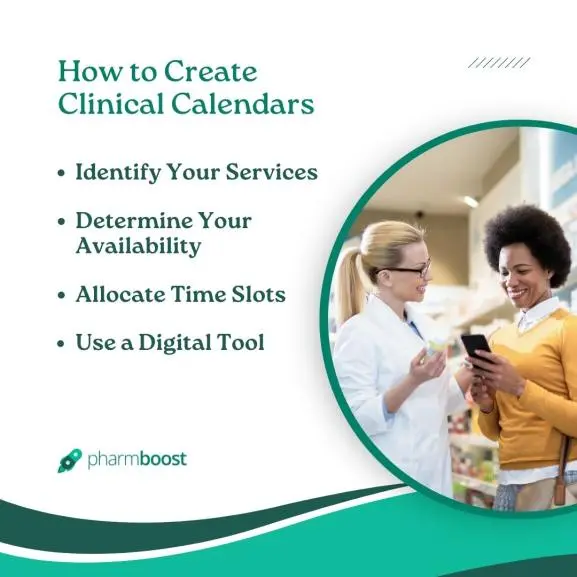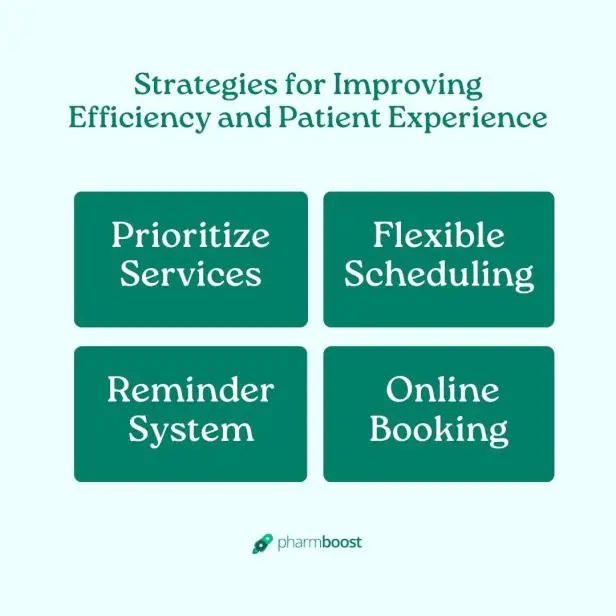Clinical Calendars
In the ever-evolving landscape of healthcare, the role of pharmacists has expanded far beyond the traditional tasks of dispensing medications. Today, pharmacists are integral members of the healthcare team, providing a range of clinical services that contribute significantly to patient care. From medication therapy management and immunizations to health screenings and disease state management, pharmacists play a pivotal role in improving patient outcomes and enhancing the quality of care.
However, with this expanded role comes increased responsibilities and challenges. One of the key challenges is managing the diverse range of services efficiently. This is where clinical calendars come into play. A clinical calendar is a powerful tool that helps pharmacists organize their services, manage their time effectively, and ensure that patients receive the care they need when they need it.
Creating a clinical calendar involves identifying the services you offer, determining your availability, and allocating time slots for each service. It requires careful planning and consideration to ensure that your schedule aligns with your services and availability. But the effort is well worth it. A well-structured clinical calendar can streamline your workflow, reduce stress, and improve patient satisfaction.
Moreover, in today’s digital age, there are numerous tools available that make creating and managing clinical calendars easier than ever. Digital calendar tools allow you to create flexible schedules, adjust appointments easily, and even send automated reminders to patients. By leveraging these tools, you can enhance your efficiency and provide better care to your patients.
As pharmacists, our ultimate goal is to improve patient health and wellbeing. By creating clinical calendars based on our services and availability, we can ensure that we are able to provide our patients with timely, efficient, and effective care. So whether you’re an independent pharmacist in a small town or part of a large pharmacy chain in a bustling city, creating a clinical calendar is an essential step towards achieving this goal.
In this guide, we will delve deeper into the importance of clinical calendars for independent pharmacies, discuss the benefits of creating clinical calendars based on your services and availability, provide a step-by-step guide on how to create clinical calendars, and share strategies for improving efficiency and enhancing patient experience. So let’s get started on this journey towards better pharmacy management!
Importance of Clinical Calendars for Independent Pharmacies
The importance of clinical calendars for independent pharmacies cannot be overstated. They are an indispensable tool that plays a crucial role in the day-to-day operations of a pharmacy.
Clinical calendars help in organizing and scheduling clinical services, ensuring that patients receive timely care. This is particularly important in today’s fast-paced world where time is of the essence. Patients rely on their pharmacies to provide them with the necessary medications and treatments at the right time. Any delay or mismanagement can lead to serious health consequences. Therefore, having a well-structured clinical calendar is not just a convenience, but a necessity.
A well-structured clinical calendar allows pharmacies to manage their time effectively. In the healthcare industry, time management is critical. Pharmacies need to juggle multiple tasks such as dispensing medications, counseling patients, managing inventory, and providing clinical services. Without proper scheduling and organization, these tasks can become overwhelming, leading to errors and inefficiencies. A clinical calendar helps pharmacies allocate their time wisely, ensuring that all tasks are completed accurately and on time.
Moreover, clinical calendars help avoid scheduling conflicts. In a busy pharmacy, there are numerous appointments and services that need to be scheduled. These may include patient consultations, medication reviews, immunization clinics, health screenings, and more. Without a proper system in place, there is a high risk of double-booking or overlooking appointments. This can lead to patient dissatisfaction and loss of business. A clinical calendar helps prevent such issues by providing a clear overview of all scheduled activities.
Furthermore, a smooth-running pharmacy is essential for maintaining a positive reputation and attracting new customers. Disorganized operations can lead to long wait times, errors in medication dispensing, and poor customer service - all of which can harm a pharmacy’s reputation. By helping pharmacies stay organized and efficient, clinical calendars contribute to improved customer satisfaction and business growth.
In addition to these operational benefits, clinical calendars also have strategic advantages. They provide valuable data that can be used for performance tracking and improvement. For instance, pharmacies can analyze their calendar data to identify peak times, staff productivity levels, and service demand patterns. This information can inform decision-making and help pharmacies optimize their operations for better performance.
Clinical calendars are much more than just scheduling tools for independent pharmacies. They are integral components of pharmacy management that contribute to efficient operations, high-quality patient care, improved customer satisfaction, and business growth. As the healthcare landscape continues to evolve, the role of clinical calendars in pharmacy practice is likely to become even more significant.
Benefits of Creating Clinical Calendars Based on Your Services and Availability

In the fast-paced world of healthcare, efficient time management is crucial. One way to achieve this is by creating a clinical calendar based on your services and availability. This approach offers several benefits, which we will explore in detail.
- Efficient Time Management
The first and perhaps most apparent benefit of creating a clinical calendar is efficient time management. By allocating specific time slots for different services, you can ensure that each task is given the attention it deserves. This approach allows you to plan your day meticulously, ensuring that no time is wasted. It also enables you to anticipate the needs of the day and prepare accordingly, thereby increasing your productivity. - Improved Patient Care
Patient care is at the heart of any healthcare service. A well-structured clinical calendar ensures that each patient receives adequate attention and care. By scheduling services, you can avoid rushing through appointments and give each patient the time they need. This not only improves the quality of care but also enhances patient satisfaction. Patients appreciate a healthcare provider who listens to them and addresses their concerns without making them feel rushed. - Increased Revenue
A well-planned clinical calendar can also lead to increased revenue. With proper scheduling, you can serve more patients in a day without compromising on the quality of care. This increase in patient volume can significantly boost your revenue. Moreover, efficient scheduling reduces the chances of appointment cancellations and no-shows, which are often a significant source of revenue loss in healthcare. - Reduced Stress
Healthcare can be a stressful field, with practitioners often juggling multiple responsibilities. A well-planned schedule can help reduce this stress by preventing overbooking and ensuring a smooth workflow. Knowing exactly what your day looks like can help you approach it with a calm and focused mind. It also ensures that you have enough time for breaks, reducing the risk of burnout.
Creating a clinical calendar based on your services and availability offers numerous benefits. It allows for efficient time management, improved patient care, increased revenue, and reduced stress. By adopting this approach, healthcare providers can enhance their service quality while also improving their own well-being.
How to Create Clinical Calendars

Creating a clinical calendar is a systematic process that involves careful planning and organization. It is an essential tool for managing the various clinical services provided by a pharmacy, ensuring efficient service delivery, and enhancing patient satisfaction. Here’s a detailed guide on how to create a clinical calendar:
- Step 1: Identify Your Services
The first step in creating a clinical calendar is to identify all the clinical services that your pharmacy provides. These services could range from medication therapy management, immunizations, health screenings, to patient counseling, and more. It’s important to have a comprehensive list of all these services as it forms the basis of your clinical calendar. - Step 2: Determine Your Availability
The next step is to determine your working hours and days. This involves identifying the times when you are available to provide the listed services. It’s crucial to consider factors such as peak hours, staff availability, and patient convenience while determining your working schedule. Remember, the goal is to ensure that your services are accessible to your patients when they need them. - Step 3: Allocate Time Slots
Once you have identified your services and determined your availability, the next step is to allocate specific time slots for each service. The time allocation should be based on the nature of the service and its duration. For instance, a medication therapy management session might require more time compared to an immunization service. Therefore, it’s important to allocate time slots appropriately to ensure efficient service delivery. - Step 4: Use a Digital Tool
The final step in creating a clinical calendar is to use a digital calendar tool. A digital tool not only makes it easier to create your schedule but also simplifies the process of managing and adjusting it as needed. With a digital tool, you can easily update your schedule, send reminders to patients, and even allow patients to book appointments online.
Creating a clinical calendar requires careful planning and organization. By identifying your services, determining your availability, allocating time slots appropriately, and using a digital tool, you can create an effective clinical calendar that enhances service delivery and patient satisfaction.
Strategies for Improving Efficiency and Patient Experience

In the rapidly evolving healthcare landscape, pharmacies in the United States are increasingly focusing on improving efficiency and enhancing patient experience. Here are some strategies that can be employed:
- Prioritize Services
It is crucial to prioritize services based on their importance and demand. This involves identifying the most critical services that your pharmacy offers and ensuring they are readily available. For instance, medication dispensing is a core service that should be prioritized. Additionally, consider the demand for services like immunizations, medication therapy management, and health screenings. Prioritizing these services can help streamline operations and improve patient satisfaction. - Flexible Scheduling
Offering flexible scheduling options can greatly enhance the patient experience. This could include extended hours of operation or weekend availability, which can accommodate patients who may not be able to visit during traditional business hours. Furthermore, providing options for walk-in services or same-day appointments can also increase accessibility for patients. - Reminder System
Implementing a reminder system can significantly improve medication adherence among patients. This could involve automated phone calls, text messages, or emails to remind patients about their upcoming appointments or when it’s time to refill their prescriptions. A robust reminder system not only enhances patient care but also improves pharmacy workflow by reducing last-minute prescription refill requests. - Online Booking
In today’s digital age, allowing patients to book appointments online can greatly enhance convenience. An online booking system enables patients to schedule appointments at their convenience, reducing wait times and improving the overall patient experience.
In conclusion, by prioritizing services, offering flexible scheduling, implementing a reminder system, and allowing online booking, pharmacies in the United States can significantly improve their efficiency and enhance the patient experience. These strategies not only benefit patients but also help pharmacies stand out in a competitive market.
Conclusion
In the dynamic world of healthcare, where the focus is increasingly shifting towards patient-centric care, the role of pharmacists is evolving. We are no longer just dispensers of medication; we are healthcare providers who make a significant difference in our patients’ lives. As pharmacists in the USA, we are at the forefront of this change, providing crucial healthcare services that go beyond the traditional scope of pharmacy.
Creating a clinical calendar is a vital step in this journey. It not only aids in efficient time management but also enhances patient care and boosts revenue. A well-structured clinical calendar allows us to streamline our services, ensuring that each patient receives timely care and attention. It helps us to plan our day better, allocate resources effectively, and avoid last-minute chaos. It also enables us to track our progress and make necessary adjustments to improve our service delivery.
But creating a clinical calendar is not an easy task. It requires careful planning, understanding of our services, and knowledge of our availability. This is where Pharmboost comes into play. Pharmboost is a comprehensive pharmacy management tool that simplifies the process of creating a clinical calendar. It takes into account your services, availability, and other factors to create a customized clinical calendar that suits your needs.
Pharmboost also provides other features that enhance pharmacy management. It offers inventory management solutions, patient management tools, and billing systems, among others. These features not only help in managing the pharmacy efficiently but also contribute to improving patient care and increasing revenue.
So why wait? Start creating your clinical calendar today with Pharmboost and take a step towards better pharmacy management. Remember, as pharmacists, we have the power to make a difference in our patients’ lives. Let’s continue to boost our profession with tools like Pharmboost that enhance our service delivery!
In conclusion, embracing tools like clinical calendars and comprehensive pharmacy management systems like Pharmboost is not just about improving efficiency or increasing revenue; it’s about transforming the way we deliver healthcare services. It’s about making a difference in our patients’ lives. So let’s take this step together towards better pharmacy management and enhanced patient care! Let’s boost our profession with Pharmboost!
Recent Post
- 5 Actionable Tips to Improve Patient Engagement within 1 Month
- Social Media Check List for Pharmacy Social Media Marketing
- Pharmacy Social Media Marketing 13 dos and don’ts to know
- Patient Engagement Barriers in Your Pharmacy & How Software Can Help You Overcome Them
- How to Attract New Patients and Boost Sales with Local Pharmacy Marketing







